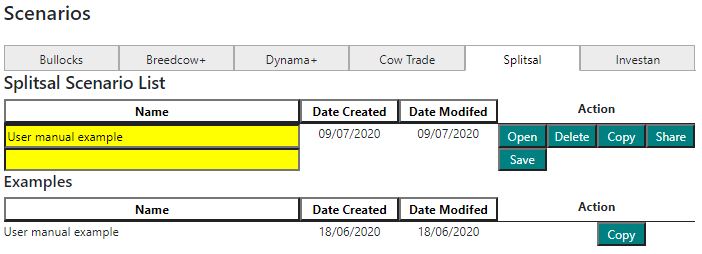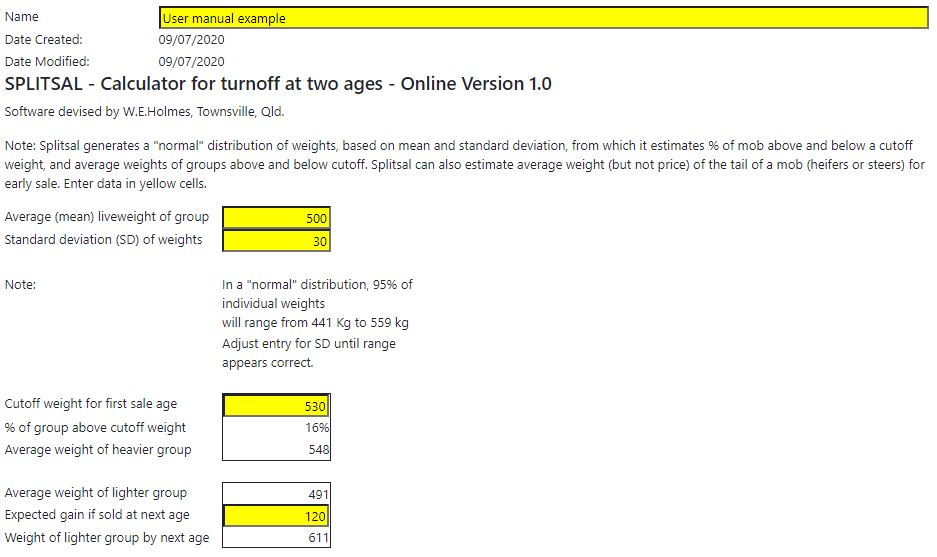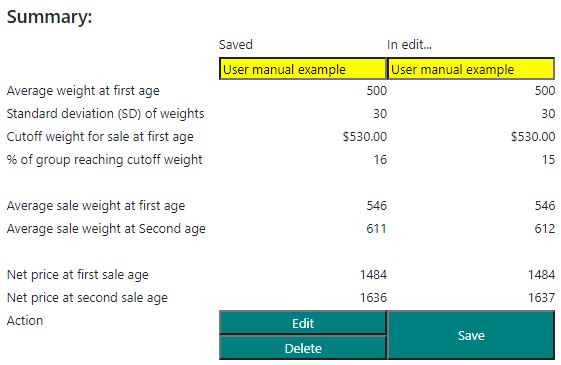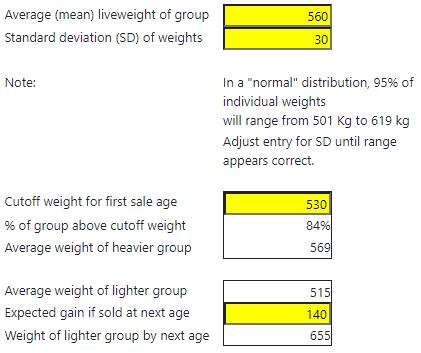Difference between revisions of "Splitsal"
m |
|||
| (107 intermediate revisions by 2 users not shown) | |||
| Line 1: | Line 1: | ||
| − | A common situation in extensive herds is that the sale of stock from one age cohort can be spread over two separate time periods up to one year apart, with the first draft of steers or heifers going when they reach the target weight and the second a year or season later, e.g. some of the bullocks may go at three and a half years, and the balance at four and a half. | + | ==Summary== |
| − | + | A common situation in extensive herds is that the sale of stock from one age cohort can be spread over two separate time periods up to one year apart, with the first draft of steers or heifers going when they reach the target weight and the second a year or season later, e.g. some of the bullocks may go at three and a half years, and the balance at four and a half. Producers will usually have some idea, based on experience, of what proportion they expect to get off at the earlier weight and the average turnoff weights at each age. | |
| − | Producers will usually have some idea, based on experience, of what proportion they expect to get off at the earlier weight and the average turnoff weights at each age. | ||
But what happens when growth is improved such as by pasture development, a reduced stocking rate, supplementation or genetic improvement? The Splitsal program can be used to consider the approximate change in the proportion turned off from a mob of cattle under such circumstances. | But what happens when growth is improved such as by pasture development, a reduced stocking rate, supplementation or genetic improvement? The Splitsal program can be used to consider the approximate change in the proportion turned off from a mob of cattle under such circumstances. | ||
The [[Splitsal]] program can be used to: | The [[Splitsal]] program can be used to: | ||
| − | |||
*predict the effect of increased growth on proportions turned off at each age in a split turnoff and | *predict the effect of increased growth on proportions turned off at each age in a split turnoff and | ||
*estimate average turnoff weights at each age for both growth patterns. | *estimate average turnoff weights at each age for both growth patterns. | ||
| − | + | *for more detailed explanation on the principles behind the the Splitsal program and its assumptions go to [[Splitsal_assumptions|Splitsal assumptions]]. | |
| + | |||
Note: There are no direct links between the Splitsal program and any other [[https://breedcowdynama.com.au Breedcow and Dynama]] program although sale weights can be manually transferred to [[Breedcow+]] and [[Dynama+]]. | Note: There are no direct links between the Splitsal program and any other [[https://breedcowdynama.com.au Breedcow and Dynama]] program although sale weights can be manually transferred to [[Breedcow+]] and [[Dynama+]]. | ||
| + | |||
---- | ---- | ||
| − | |||
| − | The program is located with the [[https://breedcowdynama.com.au Breedcow and Dynama]] software, within the ''Tools'' tab, which can be accessed after registering or logging in to use the free software. | + | ===Using the Splitsal program=== |
| + | |||
| + | The program is located with the [[https://breedcowdynama.com.au Breedcow and Dynama]] software, within the ''Tools'' tab, which can be accessed after registering or logging in to use the free software. Figure 1 below displays the Splitsal scenario list page. | ||
*A new scenario can be created by clicking the ''Save'' button beside a blank yellow name bar and can be named by typing in the yellow bar. This scenario or previously created scenarios can be edited by clicking the ''Open'' button. | *A new scenario can be created by clicking the ''Save'' button beside a blank yellow name bar and can be named by typing in the yellow bar. This scenario or previously created scenarios can be edited by clicking the ''Open'' button. | ||
*To open an example scenario click the ''Copy'' button beside the example scenario and it will be copied into your scenario list where it can be opened as your own scenario. | *To open an example scenario click the ''Copy'' button beside the example scenario and it will be copied into your scenario list where it can be opened as your own scenario. | ||
| − | *A scenario can be shared with another user by clicking the Share button then entering in the email address for the user you wish to share it with. Note that this must be the email they have used to register their account with at https://breedcowdynama.com.au the shared scenario will appear in their scenarios list for the relevant program [[ | + | *A scenario can be shared with another user by clicking the Share button then entering in the email address for the user you wish to share it with. Note that this must be the email they have used to register their account with at https://breedcowdynama.com.au the shared scenario will appear in their scenarios list for the relevant program. |
| + | |||
| + | [[file:Splitsal_1.JPG|center|frame|Figure 1 - Splitsal scenario list]] | ||
| + | |||
| + | |||
| + | ==Example one== | ||
| + | Copy the '''''User manual example''''' scenario from the examples list and open the scenario, this will illustrate how the program may be used in the following example. | ||
| − | |||
| − | |||
| − | |||
''Note: The yellow cells are for inputs and can be adjusted, while the rest are calculated outputs.'' | ''Note: The yellow cells are for inputs and can be adjusted, while the rest are calculated outputs.'' | ||
| + | |||
| + | '''The first step in Splitsal is to enter values in the yellow cells for; ''Average live weight of group'', ''Standard deviation of weights'', ''Cut-off weight for first sale age'' and ''Expected gain if sold at next age''.''' | ||
| + | |||
| + | *In the example, the cut-off weight for a group of steers is 530kg (required turnoff weight) at three and a half years. The [[Splitsal_assumptions#Average (mean)|average]] (mean) weight of the group at three and a half years is estimated to be 500kg with a [[Splitsal_assumptions#Standard Deviation (SD)|standard deviation]] (SD) of 30kg. The expected [[Splitsal_assumptions#Annual Live Weight Gain|annual live weight gain]] for older steers is 120kg. Figure 2 below shows the initial data input boxes for the program. | ||
| + | |||
| + | [[file:Splitsal2.JPG|frame|center|Figure 2 - Splitsal data input]] | ||
| + | |||
| + | *The standard deviation defines the variation of weights either side of the average figure. Users can play with the entry for standard deviation until the range of weights displayed appears to represent 95% of the group under consideration. In figure 1 the indicated range (for 95% of the group) is 441kg to 559kg. Changing the value for standard deviation will change this range. | ||
| + | |||
| + | *For the data entered so far, the program has calculated that 16% of the total group will be above the cut-off weight of 530kg at three and a half years old. This 16% of the group (the leads) have an average weight of 548kg. The other 84% (the tails) have an average weight of 491kg. If they are expected to gain another 120kg over the next year this would give them an average turnoff weight at four and a half years old of about 611kg. | ||
| + | |||
| + | |||
---- | ---- | ||
| − | |||
| − | + | '''The second step in Splitsal calculates a net price for the leads group (sold at 1st age) and tails group (sold at 2nd age).''' | |
| + | |||
| + | *From the weights entered, and after entering; ''Price/Kg'', ''Selling Costs (charged as a % of value or per head)'' and ''Transport Cost/Head'' the ''Net Price/Head'' is valued at $1489 and $1636 for the leads and tails respectively. Figure 3 illustrates the net price calculation. | ||
| + | |||
| + | [[file:Splitsal3.JPG|center|thumb|frame|950px|Figure 3 - Net price calculation]] | ||
| + | |||
| + | |||
| + | ---- | ||
| − | ''' | + | '''At the completion of a scenario and before starting to test different options for this group of animals, Splitsal allows users to save a summary within the scenario file.''' |
| − | + | *To do this, simply click the ''save'' button below the scenario in edit at the bottom of the page. The scenario can be named by typing in the yellow cell. Users can edit and save multiple scenarios and compare them in the summary columns as seen in Figure 4 below. | |
| − | |||
| − | |||
| − | + | [[file:Splitsal4.JPG|center|frame|Figure 4 - Summary scenarios]] | |
| − | |||
| − | + | ---- | |
| − | + | '''Splitsal can also be used to estimate the impact of an increase in the weight gain of a group of sale cattle.''' | |
| − | + | *If the weight gain of the previously described group of steers is increased by 20 kilograms per year post-weaning (now 140kg/annum) by the use of some herd improvement strategy, the average weight at three and a half years will increase to 560 kilograms with 86 percent of the steers now making the cut-off weight at three and a half years. Once the average (mean) live weight of group value is changed from 500 to 560, the calculated values in Splitsal will be automatically recalculated. See the changed inputs in Figure 5 below. | |
| − | * | + | *The predicted average weight of the carryover group is up from 491 to 515 kilograms. The average weight at four and a half years, including allowance for an extra 20 kilograms growth, is now 655 kilograms, up from 611 previously. |
| − | + | [[file:Splitsal5.JPG|center|frame|Figure 5 - Splitsal recalculation following expected additional weight gain]] | |
| − | |||
| − | + | ---- | |
| − | The net price per head will now be $1, | + | '''The net price per head will now be $1,547 and $1,756 with the additional weight gain. See Figure 6 below for updated results of the simulation.''' |
| − | + | [[file:Splitsal6.JPG|center|frame|Figure 6 - Updated results of simulation]] | |
---- | ---- | ||
| − | '''For more detailed explanation on the principles behind | + | '''For more detailed explanation on the principles behind the Splitsal program and its assumptions go to [[Splitsal_assumptions|Splitsal assumptions]].''' |
---- | ---- | ||
Latest revision as of 00:50, 6 June 2023
Summary
A common situation in extensive herds is that the sale of stock from one age cohort can be spread over two separate time periods up to one year apart, with the first draft of steers or heifers going when they reach the target weight and the second a year or season later, e.g. some of the bullocks may go at three and a half years, and the balance at four and a half. Producers will usually have some idea, based on experience, of what proportion they expect to get off at the earlier weight and the average turnoff weights at each age.
But what happens when growth is improved such as by pasture development, a reduced stocking rate, supplementation or genetic improvement? The Splitsal program can be used to consider the approximate change in the proportion turned off from a mob of cattle under such circumstances.
The Splitsal program can be used to:
- predict the effect of increased growth on proportions turned off at each age in a split turnoff and
- estimate average turnoff weights at each age for both growth patterns.
- for more detailed explanation on the principles behind the the Splitsal program and its assumptions go to Splitsal assumptions.
Note: There are no direct links between the Splitsal program and any other [Breedcow and Dynama] program although sale weights can be manually transferred to Breedcow+ and Dynama+.
Using the Splitsal program
The program is located with the [Breedcow and Dynama] software, within the Tools tab, which can be accessed after registering or logging in to use the free software. Figure 1 below displays the Splitsal scenario list page.
- A new scenario can be created by clicking the Save button beside a blank yellow name bar and can be named by typing in the yellow bar. This scenario or previously created scenarios can be edited by clicking the Open button.
- To open an example scenario click the Copy button beside the example scenario and it will be copied into your scenario list where it can be opened as your own scenario.
- A scenario can be shared with another user by clicking the Share button then entering in the email address for the user you wish to share it with. Note that this must be the email they have used to register their account with at https://breedcowdynama.com.au the shared scenario will appear in their scenarios list for the relevant program.
Example one
Copy the User manual example scenario from the examples list and open the scenario, this will illustrate how the program may be used in the following example.
Note: The yellow cells are for inputs and can be adjusted, while the rest are calculated outputs.
The first step in Splitsal is to enter values in the yellow cells for; Average live weight of group, Standard deviation of weights, Cut-off weight for first sale age and Expected gain if sold at next age.
- In the example, the cut-off weight for a group of steers is 530kg (required turnoff weight) at three and a half years. The average (mean) weight of the group at three and a half years is estimated to be 500kg with a standard deviation (SD) of 30kg. The expected annual live weight gain for older steers is 120kg. Figure 2 below shows the initial data input boxes for the program.
- The standard deviation defines the variation of weights either side of the average figure. Users can play with the entry for standard deviation until the range of weights displayed appears to represent 95% of the group under consideration. In figure 1 the indicated range (for 95% of the group) is 441kg to 559kg. Changing the value for standard deviation will change this range.
- For the data entered so far, the program has calculated that 16% of the total group will be above the cut-off weight of 530kg at three and a half years old. This 16% of the group (the leads) have an average weight of 548kg. The other 84% (the tails) have an average weight of 491kg. If they are expected to gain another 120kg over the next year this would give them an average turnoff weight at four and a half years old of about 611kg.
The second step in Splitsal calculates a net price for the leads group (sold at 1st age) and tails group (sold at 2nd age).
- From the weights entered, and after entering; Price/Kg, Selling Costs (charged as a % of value or per head) and Transport Cost/Head the Net Price/Head is valued at $1489 and $1636 for the leads and tails respectively. Figure 3 illustrates the net price calculation.
At the completion of a scenario and before starting to test different options for this group of animals, Splitsal allows users to save a summary within the scenario file.
- To do this, simply click the save button below the scenario in edit at the bottom of the page. The scenario can be named by typing in the yellow cell. Users can edit and save multiple scenarios and compare them in the summary columns as seen in Figure 4 below.
Splitsal can also be used to estimate the impact of an increase in the weight gain of a group of sale cattle.
- If the weight gain of the previously described group of steers is increased by 20 kilograms per year post-weaning (now 140kg/annum) by the use of some herd improvement strategy, the average weight at three and a half years will increase to 560 kilograms with 86 percent of the steers now making the cut-off weight at three and a half years. Once the average (mean) live weight of group value is changed from 500 to 560, the calculated values in Splitsal will be automatically recalculated. See the changed inputs in Figure 5 below.
- The predicted average weight of the carryover group is up from 491 to 515 kilograms. The average weight at four and a half years, including allowance for an extra 20 kilograms growth, is now 655 kilograms, up from 611 previously.
The net price per head will now be $1,547 and $1,756 with the additional weight gain. See Figure 6 below for updated results of the simulation.
For more detailed explanation on the principles behind the Splitsal program and its assumptions go to Splitsal assumptions.





